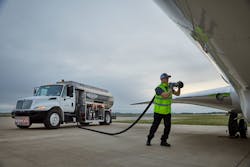Clean Supply: Preventing Aviation Fuel Contamination
All fuel needs to be clean and to the correct standards to perform properly and keep machinery functioning. No other fuel may go through the intense scrutiny of aviation fuel, however.
It’s a rigorous process of checks and tests at each step from production to aircraft tank. But even so, there is always the chance for mistakes or contamination to take place somewhere in the process.
Ensuring clean, dry fuel makes it to an aircraft is critical to pilot and passenger safety. As Keith Clark, quality control and technical support rep, Phillips 66 Aviation, says, there are no pit stops when you’re flying.
“You got to remember – aircraft have no place to pull over in the sky. If it's a car and it breaks down, we call a mechanic in or a tow truck and get it fixed,” Clark says. “That's why there's so many procedures in place and so much extra care is given on aviation fuel. With all the filtration, all this testing, because it's got to be perfect throughout the process.”
Test, Filter and Test Again
Clark says it’s important to understand the entire fueling process so it is known where, when and how a possible contamination or mishandling might occur.
It all starts at the refinery where the very first tests on the fuel begin. Aviation fuel is either jet fuel or avgas 100 low lead. Jet fuel is tested to ASTM spec D1655 and Avgas is tested to ASTM D910.
“Then once it meets the specs and it's on the spec, then it's moved to terminals or throughout the system to get out closer to the FBOs. Once they move the fuel, then it's retested, and there's a certificate of analysis.
“That's basically saying, ‘Hey, the fuel got moved. It's in this system now. We're going to do a certificate of analysis to make sure it's still on spec for 1655 or ASTM D910 on avgas.’ Once it gets to the terminal, then we have dedicated trailers that are dedicated for avgas or dedicated for jet fuel,” Clark says.
Before it gets on those trailers, however, it’s put through a filter to remove water and any particulates that might be contaminating the fuel. Clark notes that other fuels, such as gasoline for cars and trucks, do not go through such rigorous standards.
“We tested it. It made it. We moved it to the terminal. We did another test on it to get an analysis to verify it's still on. Now we're going to run it through filters to take out water and particulate before it even goes on the transport trailer,” Clark adds.
The transport trailer then takes the fuel to the FBOs, where the avgas or jet fuel will be checked again with a white bucket test, again checking to make sure the fuel is free of contaminants. Then an API Gravity test is performed to make sure the fuel matches with what was recorded at the terminal, plus or minus a degree, said Clark.
If it’s jet fuel that is meant to have anti-icing fluid added to it at the terminal, then an additional check is performed to make sure that additive is present via a FSII test. That happens prior to it leaving the transport truck to ensure everything is correct before it goes into an FBO’s fuel farm.
“Then once it leaves the transport trailer, it's filtered into the FBO fuel farm. Goes through filtration. Now, some FBOs don't filter in. They do gravity drops and other stuff, but the industry says, ‘It should be filtered in.’ Remember, at the terminal we filtered it in the truck. Before leaving truck, we're going to filter it again into the FBO fuel farm,” Clark says.
When it’s ready to move from the fuel farm to the designated aircraft, the fuel is filtered again from the farm to the refueler truck. It’s then filtered one last time as it leaves the refueler truck, reaching its final destination into an aircraft.
“If you add all those things up, this fuel has been filtered three, four times,” Clark says. “Those are all things that are in the process and the steps to make sure that the fuel is still clear, clean and bright -- clear of debris.”
And while the fuel sits at the fuel farm or in a refueler waiting to move again, it is sumped daily.
“Every day we're going out and sumping it. Water particulate is heavier than fuel. It's all down at the bottom. We're going to get it out of the tank,” Clark says.
“If we do have a water particulate, we want to get it out. The filters are there as backup, but we don't want to just say, ‘Hey, our filters will take it out.’ We sump it out manually.”
In addition to the farm and trucks, the filters themselves are also sumped daily.
“Filter vessels, they also have sumps in them, so we sump that filter vessel at the fuel farm and on the truck daily. The filter vessels also have differential pressure gauges that are monitoring the differential pressure in that filter vessel. As a filter gets dirty, the differential pressure is going to go up,” Clark says.
“We know where the beginning was, and we monitor it to make sure if it gets over 15 PSI, we're going to shut down the system and find out what's going on.”
No Such Thing as Perfect
It might sound like a fool-proof system, but Clark says fuel handling personnel must remain vigilant. He stresses that at every stage of this process, there are people behind it performing the operations, and nobody is perfect. Mistakes can be made at any point, and it only takes one to bring a plane down.
“There's a lot of safety protocol put in. But keep in mind, it's all done by humans. When people start skipping steps or not doing what they're supposed to, that's when you can start having issues. That's why we have record keeping and processing, auditing, to verify and go back. The one thing you don't want to do is find out you have an aircraft accident, and then you go back and look at your records and find out somebody's been skipping two or three of these steps. They're not checking in the fuel right or whatever. They're not following the procedures,” Clark says.
Water and other contaminants can enter into a fuel supply at any time. Water is the main contaminant operators should be concerned of as it leeches into fuel merely from the air around it.
“Every one of those tanks, fuel tanks, and that truck, even the aircraft, are vented to the atmosphere. Every time we pump fuel out of that tank into the refueler truck, or from the refueler truck to the aircraft, we're sucking in air. Air has particulate and water in it, so we're sucking in contaminants. That's why we have filtration to remove that stuff, and that's why we do something,” Clark says.
The warmer the fuel, the more water it can hold. It’s why those in hot and humid climates need to be especially cautious. Clark says that when it’s 70 degrees F, fuel can hold 70 parts per million of water. If that water is in the fuel, it will cool as the plane ascends – possibly forming into ice and creating problems.
“That's why some aircraft, jet aircraft, require pretreated jet fuel that has anti-icing additive. Other aircraft have heat exchangers on their tanks to keep the fuel warm, and it keeps that water from freezing. If you don't have that and the water falls out of the fuel, now you've got water up in the sky in your aircraft. The same thing that happens in our fuel tanks with the FBO happens in the aircraft. That's why we tell people, ‘You have to sump your aircraft,’” Clark says.
Don’t Trust – Verify
With all the checks and balances in place and employees following the correct protocols, preventing fuel contamination from the environment is manageable. A greater threat, though, can be preventing cross contaminations of fuels due to human error.
“You always have that risk of cross contamination. One of the things when we're receiving fuel into the FBO, you've got tanks, you've got jet tanks and you've got avgas tanks. That transport truck can hook up to anything,” Clark says.
If avgas and jet fuel ever become accidentally contaminated with the other, the whole batch has to be discarded.
“Unfortunately, over the years, that's happened. They've accidentally put jet fuel into an avgas tank, avgas into a jet tank because they're not thinking (or) because there's no security on those padlocks, on those fill points,” Clark says.
One of the ways to prevent cross contamination is with each fill point being locked with separate locks requiring separate keys and key chains labelling them as either for avgas or jet fuel.
“But if you have separate keys, don't carry the keys on your keyring. Have separate keys with the equipment that you need to do the task. We have key chains available that say, "Jet" or "Avgas 100," and that's just a best practice that says, ‘Hey, if I got the jet key because I'm supposed to be getting jet fuel in, the only thing I should be able to open up back there is the jet tank. I shouldn't be able to open up the avgas.’”
Further, there should be separate equipment for each fuel type as well that, again, can only be accessed with the correct key for the fuel type being received.
To help reinforce the importance of verifying the correct fuel type throughout the entire process of refueling planes, Clark created the “Save a Life, Verify Fuel Type” campaign. Through heart shaped decals, key chains and other paraphernalia that can be easily seen or attached to work equipment, the campaign aims to remind workers to stop, think and verify they are using the correct fuel in the correct situations to avoid misfuelings.
“The only time you ever need to get into that fill point is when you're offloading a truck. If you're offloading a truck, you're going to have your hydrometers there to check the API gravity. You're going to have your white bucket. We recommend dedicated equipment. So have dedicated white buckets for jet fuel. Your hydrometers are dedicated because jet fuel is heavier than avgas, so they're going to use a hydrometer that's like 39 to 51 scale, where avgas is going to use something like a 59 to 71, or a 69 to 81,” Clark says.
The most surefire way to prevent contamination of any kind is by auditing and making sure the correct procedures are always being maintained.
“We always tell them, ‘Hey, go audit your record keeping. Don't wait until you have an aircraft accident to go audit it. Go look at it now. Just like a fire drill, you can practice an action and drill any day.’ Just say, ‘Hey, this aircraft didn't go down, but say this one did. Let's go back and trace the fuel that went into that aircraft all the way back to the day we received it and make sure that we have all the records in place that show that this fuel is clear and bright, clean and dry, on spec.,’” Clark says.
About the Author
Walker Jaroch
Editor
Contact: Walker Jaroch
Editor | AMT
+1-920-568-8399
>> To download the AviationPros media kits, visit: Marketing Resource Center
>>Check out our aviation magazines: Ground Support Worldwide | Airport Business | Aircraft Maintenance Technology

